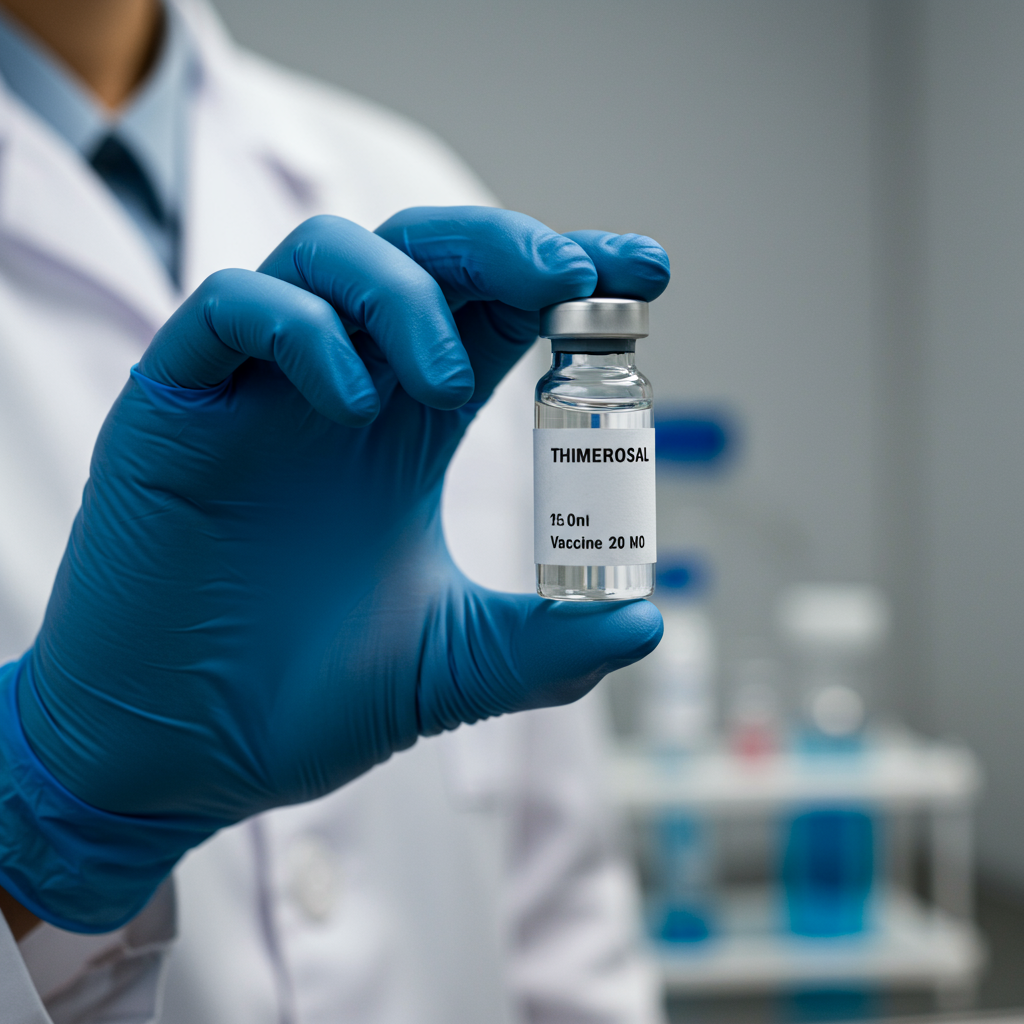A vaccine preservative recently thrust into headlines by a US health chief has sparked renewed questions: What exactly is thimerosal, and does it pose risks? While largely removed from most vaccines decades ago, its presence in a small subset of flu shots has fueled ongoing debate. This article clarifies the science behind thimerosal, its historical use, current status, and why health experts widely regard it as safe.
What is Thimerosal and Why Was it Used?
Thimerosal is a mercury-based compound that served a crucial role in vaccine manufacturing. Added to multi-dose vials, it acts as a preservative. Its primary function is to prevent harmful bacteria and fungi from contaminating the vaccine. This contamination risk arises when a needle enters a vial multiple times to draw doses. The introduction of microbes into a vaccine could potentially cause severe local reactions, serious illness, or even death if administered. Therefore, preservatives like thimerosal were vital for ensuring the safety of vaccines stored in multi-dose formats used across many patients.
Ethylmercury vs. Methylmercury: A Key Difference
Concerns about thimerosal often stem from its mercury content. However, understanding the type of mercury is critical. Many people are familiar with warnings about mercury consumption, especially in seafood, which relate to methylmercury. Methylmercury is known to be toxic at high levels because the body struggles to eliminate it, allowing it to accumulate over time.
Thimerosal contains ethylmercury. This is a key distinction. Human bodies process and excrete ethylmercury far more quickly than methylmercury. This rapid excretion means ethylmercury is significantly less likely to build up in the body and cause harm. Scientific studies consistently highlight this difference, underscoring why comparisons between the two forms of mercury are misleading in the context of vaccine safety.
The Historical Context of Thimerosal Removal
Despite scientific evidence suggesting thimerosal’s safety at vaccine doses, public concern grew in the late 1990s. In response, and out of an “abundance of caution,” US health authorities and vaccine manufacturers began phasing thimerosal out of most vaccines in 2001. Experts emphasize that this action was taken as a precaution to address public perception, not because research had proven thimerosal to be unsafe. Dr. Rachel Roper, a professor of microbiology and immunology, noted that studies conducted after the removal ultimately showed thimerosal’s safety.
By 2001, thimerosal was removed from nearly all vaccines routinely recommended for children age six and younger. In fact, some common childhood vaccines, such as the measles, mumps, and rubella (MMR) vaccine, the varicella (chickenpox) vaccine, and the inactivated polio vaccine, never contained thimerosal to begin with. Today, the standard pediatric vaccine schedule in the US allows children to be fully immunized using only thimerosal-free vaccines.
Thimerosal in Today’s Vaccine Supply
While largely gone from childhood immunizations, thimerosal is still used in a small fraction of vaccines today. Its primary remaining use is in certain multi-dose vials of the influenza vaccine. Vaccine manufacturers have increasingly moved towards producing single-dose, pre-filled syringes, which do not require a preservative like thimerosal because they are used only once. This shift has naturally reduced the need for thimerosal.
For the 2024-2025 and 2025-2026 flu seasons, only a small number of the available flu vaccine formulations in the US contain thimerosal. According to data cited by experts, about 96% of the total US flu vaccine supply consists of single-dose, thimerosal-free syringes. Multi-dose vials containing thimerosal make up roughly 4%. Pediatric and prenatal flu shots are typically administered from single-dose, thimerosal-free presentations, making real-world exposure to thimerosal in vaccines even lower for these groups.
Addressing Safety Concerns: The Science Speaks
Thimerosal’s safety has been extensively studied for decades. Numerous scientific investigations have consistently found no evidence of harm from the amount of ethylmercury present in vaccines. Research indicates that the body efficiently clears ethylmercury, preventing dangerous accumulation.
The Autism Link: A Debunked Claim
Perhaps the most persistent claim against thimerosal is that it causes autism. This hypothesis gained traction years ago but has been thoroughly investigated and repeatedly disproven by robust scientific studies across multiple countries. Major health organizations, including the CDC, FDA, and the World Health Organization, agree that there is no causal link between thimerosal-containing vaccines and autism spectrum disorders. Studies have shown that removing thimerosal from childhood vaccines in the US did not lead to a decrease in autism rates; in fact, rates continued to rise, which contradicts the idea that thimerosal caused the condition.
Experts like Dr. Mark Sawyer, a pediatric infectious disease physician, state there is “no evidence to date that thimerosal causes any harm whatsoever.” Scientific evaluations have found no association between thimerosal-containing vaccines and neurodevelopmental disorders like autism. Additionally, studies confirm that vaccinating infants with thimerosal-containing vaccines does not raise blood mercury levels above safe limits due to the body’s rapid excretion of ethylmercury. No scientific evidence supports claims that thimerosal-containing vaccines cause adverse events in children born to women vaccinated during pregnancy.
Recent Developments and Limited Impact
The safety of thimerosal recently returned to the spotlight during a meeting of the US Department of Health and Human Services (HHS) vaccine panel. The HHS Secretary, Robert F. Kennedy Jr., a long-time leader in the anti-vaccine movement, has publicly described thimerosal as “toxic” and a “potent neurotoxin,” citing claims unsupported by scientific consensus. The panel voted to stop recommending flu vaccines that contain thimerosal.
However, public health experts note that this recommendation will likely have limited practical impact. Given that thimerosal-containing flu vaccines constitute such a small percentage of the overall supply, the recommendation primarily formalizes a preference for the already widely available thimerosal-free options. Experts suggest the vote might potentially make flu shots slightly more expensive or less accessible in very specific areas due to logistics, but it doesn’t reflect new scientific findings on safety. The overwhelming scientific consensus remains that thimerosal in vaccines, in the trace amounts still used, is safe.
Frequently Asked Questions
What is Thimerosal and why is ethylmercury different?
Thimerosal is a mercury-based compound used as a preservative in some vaccines, primarily in multi-dose vials, to prevent bacterial and fungal contamination. It contains ethylmercury, which the human body can break down and eliminate quickly. This is distinctly different from methylmercury, found in certain fish, which accumulates in the body and is toxic at high levels. The rapid excretion of ethylmercury is why the small amounts in vaccines are considered safe.
Where can I find thimerosal-free vaccines today?
Thimerosal was removed from most US vaccines starting in 2001 as a precaution. Today, all vaccines routinely recommended for children age six and younger are available in thimerosal-free formulations, and many childhood vaccines never contained it. While a small portion of multi-dose flu vaccine vials still contain thimerosal, about 96% of the total US flu vaccine supply consists of single-dose, thimerosal-free syringes, making thimerosal-free options widely available, especially for pediatric and prenatal use.
Should I worry about thimerosal in flu shots or childhood vaccines?
Based on extensive scientific research and the consensus of major health organizations like the CDC and FDA, there is no evidence that thimerosal in vaccines causes harm. It has been removed from nearly all childhood vaccines, and the trace amounts remaining in a small fraction of flu shots contain ethylmercury, which is safely processed and excreted by the body. Studies have repeatedly disproven any link between thimerosal and autism or other health issues.
Conclusion: Science vs. Speculation
The debate surrounding thimerosal highlights the tension between scientific evidence and public concern amplified by influential voices. While historical public anxiety led to its removal from most vaccines out of caution, subsequent and ongoing research consistently affirms its safety. The scientific consensus is clear: the small amount of ethylmercury in the remaining thimerosal-containing flu shots does not pose a health risk. As individuals consider immunization, relying on evidence-based information from trusted public health sources is crucial for making informed decisions about vaccine safety.



